Serving Guadalupe, Gonzales, Karnes, and Wilson Counties since 1983
Safety Plan
Safety Plan
This plan offers suggestions to help you stay safer while you are in an abusive relationship or planning to leave one. An advocate is available to help you create a personalized safety plan at our hotline 24/7 at 1-800-834-2033.
1: Safety during an explosive incident.
- If an argument seems unavoidable, try to move to a room or area where you have access to an exit and phone. Avoid the bathroom, kitchen, bedroom or anywhere else where weapons might be available.
- Practice how to get out of your home safely.
- Try to hide weapons or make them inaccessible if it is safe to do so.
- Ask a trusted neighbor to call police if they hear a disturbance at your home.
- Devise a code word to use with your children, family, friends, and neighbors when you need the police.
- Decide and plan for where you will go if you have to leave home. Always have gas in your car, and have an extra key.
- Trust your own instincts and judgment. If the situation is very dangerous, consider giving the abuser what he wants to calm him down until you can get to safety. You have the right to protect yourself until you are out of danger.
2: Safety When Preparing to Leave.
- Cellphones can have GPS tracking devices. If possible, get a new account or prepaid phone when you leave.
- Get a reloadable pre-paid debit card that you can put money on whenever able. Set aside small amounts of money when possible.
- Leave money, an extra set of keys, copies of important documents, extra medicines, and clothes with someone you trust.
- Determine who would be able to let you stay with them or lend you some money.
- Keep the shelter and important phone numbers handy. Consider hiding a prepaid phone for emergency use, or so your abuser cannot monitor your phone records.
- Review your safety plan as often as possible to plan the safest way to leave your batterer.
3: Safety In your own home.
- Change the locks on your doors as soon as possible. Buy additional locks and safety devices to secure your windows.
- Discuss a safety plan with your children for when you are not with them.
- Inform your Children’s school, etc.
- Inform neighbors and landlord that your partner no longer lives with you and that they should call the police if they see him near your home.
4: Safety with a protective order.
- Always keep your protective order on you. Keep one in your purse, car, etc. Give a copy to a trusted neighbor or family member.
- Call the police if your partner breaks the protective order.
- Think of alternative ways to keep safe if the police do not respond right away.
- Inform family, friends, neighbors and your physician or health care provider that you have a protective order in effect.
5: Safety On The Job and in Public.
- Decide who at work you will inform of your situation. This should include office or building security.
- Provide a picture of the batterer and vehicle if possible.
- Change your regular routine. Consider different routes to work, school, etc.
- Devise a safety plan for when you leave work. Have someone escort you to your car, or bus and wait with you until you are safely in route. Use a variety of routes to go home if possible.
- Think about what you would do if something happened while going home (in your car, on the bus, etc.).
- Always drive to a well-lit, populated location if you feel you are being followed.
6: Safety and Technology
- Your computer activity can be monitored. It is impossible to delete all trace of your activities. If you are being monitored, it may be dangerous to delete your history if that is not your regular habit.
- When looking up information about getting help, escape plans, new jobs, or places to live, only use a safe computer that your abuser does not have access to.
- Your calls from a cell phone can be seen on your bill. Make calls to shelters, lawyers, or others for help from a public phone or a prepaid cell phone.
7: Your Safety & Emotional Health
- If you are thinking of returning to a potentially abusive situation, discuss an alternative plan with someone you trust.
- If you must communicate with your partner, determine the safest way to do so, generally in a very public spot.
- Have positive thoughts about yourself and be assertive with others about your needs. Read books, articles and poems to help you feel stronger.
- Decide who you can call to talk freely and openly to give you the support you need.
- Plan to attend a women’s or victim’s support group to gain support from others and learn more about you and the relationship.
Legal Papers:
- Your Protective Order
- Lease, Rental agreement, House deeds and Papers
- Insurance papers, medical records (you and children)
- Work Permits / Visa
- Passport
- Divorce Papers
- Custody Papers
Other:
- House and Car Keys
- Medications / Prescriptions
- Small Saleable Objects
- Jewelry
- Address Book
- Pictures of you, Children and Abuser
- Children’s Small Toys
- Toiletries / Diapers
- Change of Clothes (Yourself / Children)
CONTACT INFORMATION
BUSINESS HOURS
- Mon - Fri
- -
- Sat - Sun
- Closed
Services are Available 24/7
Content, including images, displayed on this website is protected by copyright laws. Downloading, republication, retransmission or reproduction of content on this website is strictly prohibited. Terms of Use
| Privacy Policy



